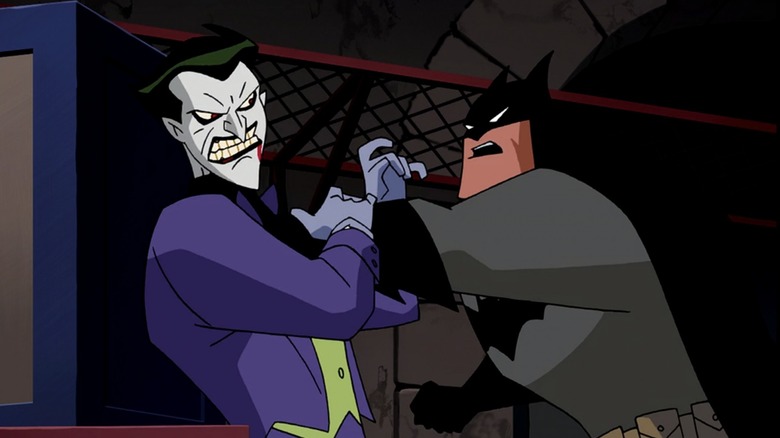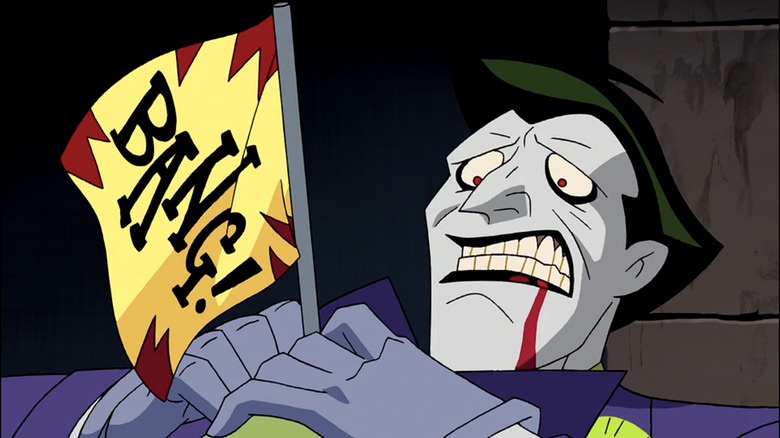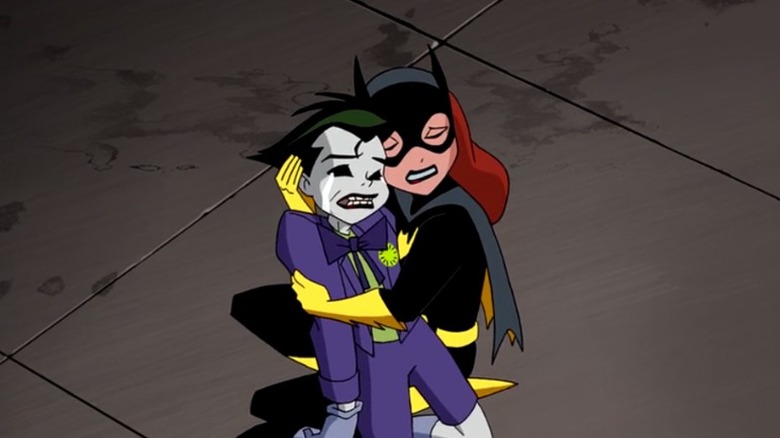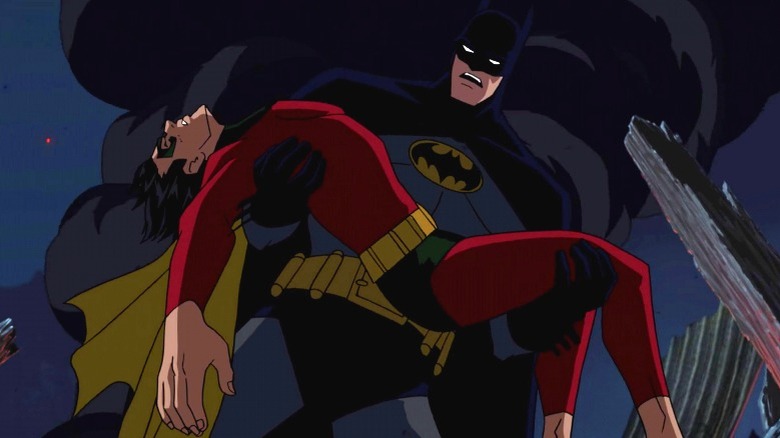How Joker Really Died In Batman Beyond - And Why Censorship Almost Ruined It
The following article includes references to gun violence
Unlike other DC hallmarks such as Superman, Batman has always had the benefit of delving into dark material. More detective than vigilante, Bruce Wayne spends his days hunting down serial killers in haunting books like essential Batman story, "The Long Halloween." But of course, no one puts Batman through the wringer more than his arch nemesis, the Joker. The Clown Prince of Gotham returns time and time again because his true delight isn't in carnage, but in torturing the Dark Knight psychologically. Harrowing stories like the controversial movie, "The Killing Joke," have a graphic reputation, but "Batman Beyond: Return of the Joker" is the real gut-punch.
In a tension-filled flashback, Terry (Will Friedle) is surprised to learn that the Joker's (Mark Hamill) death was the result of Tim Drake (Dean Stockwell) when he was still Robin (Mathew Valencia). In an ambitious plan to kill Batman (Kevin Conroy), the Joker brainwashes and tortures Tim until he resembles something of a mini Joker — maniacal laughter and all. Handing Tim a gun, the Joker points him at Batman and tells him to pull the trigger. Overwhelmed by his psychological torture, Tim shoots the Joker instead. Turning an innocent child into a murderer is thematically what Batman does best, but when the film was released in 2000, it almost wasn't meant to be. Because of the mature themes of the film, "Batman Beyond: Return of the Joker" almost didn't see the light of day.
A censored version was released initially
Batman stories have a reputation for mature content, but in the fall of 2000, "Batman Beyond: Return of the Joker" was somehow a bridge too far. After initial anticipation and release of screeners to industry professionals, Warner Bros. started recalling the project. They delayed the release date and scenes were altered to make the film less extreme.
IGN theorizes that the Batman film was retooled because Senator John McCain campaigned against violence in film and television in a famous hearing. Other outlets brought up the hot-button issue of Columbine as a likely reason. The tragic shooting occurred the year prior and could make viewers uncomfortable about seeing a child wield a gun. When the film was finally released, several scenes were changed from what early screeners had shown. Small things like seatbelts and color schemes were changed to give a more wholesome vibe. But the biggest alteration was the Joker's death. Instead of Tim intentionally pulling the trigger, he pushes the Joker into a collection of wires dangling above water. Tangled in the apparatus, the Joker dies from electrocution as the wire connect with the ground. Some may argue that this is an even more brutal way to go, but it accomplished as intended. Tim did not commit murder intentionally. It was just a strange and disturbing accident.
If you have been impacted by incidents of mass violence, or are experiencing emotional distress related to incidents of mass violence, you can call or text Disaster Distress Helpline at 1-800-985-5990 for support.
The uncut film is considered the definitive version
Since their release, the films have been popular fodder for discourse. Outlets such as SyFyWire have rallied behind the original uncut version, as have fans on Reddit. Many argue that the original version goes to emotional depths that the censored version couldn't.
"For me it did affect the emotional impact," u/kingt34 posted in a discussion thread. "The electrocution was him accidentally killing Joker, so he never crosses the line Batman never wants to cross. He just pushed Joker and the Joker accidentally kills himself. But in the original, he just straight up SHOOTS him. He's so far over the line he has to shoot the Joker out of pure desperation to escape his personal hell."
Even more devastating is realizing that even when Joker loses, he wins. Though he dies, he dies knowing that Tim will probably never recover psychologically. And what makes it even worse, Batman has to live with the knowledge that Tim never would have turned out that way if he hadn't become Robin. For Batman, this is worse than death. To put the matter to rest, prolific comic writer Dan Slott officially put his weight behind the preferred version.
"If you watch Batman Beyond: Return of the Joker, please make sure it's the Uncut ver," Slott wrote on Twitter. "The regular ver. was sanitized w/ some of the violence/deaths removed and a key sequence reanimated in such a way that robs it of all its punch."
The Joker has a thing about brutalizing Robins
Tim Drake's torture is certainly brutal, but it wouldn't be the last time the Joker would get his hands on a Robin. In many ways, "Return of the Joker" walked so "Under the Red Hood" could run. Arguably one of the most iconic Robin stories, "Under the Red Hood" opens with Joker (John DiMaggio) beating Jason Todd senselessly with a crowbar. This event ends tragically as Batman (Bruce Greenwood) races against the clock to save him. It is too late, and a bomb detonates just as Batman arrives on the scene. Jason (Jensen Ackles) returns as the Red Hood years later, but this is a visceral display of violence that turns the stomach.
DC comics have gone on to push the envelope with graphic scenes, and even toward the Joker himself. In the comic as well as the animated feature, Joker (Kevin Pollak) has a shocking death at the hands of Superman (Justin Hartley). "Injustice" features this death on the same level as "Return of the Joker." The Joker uses a form of toxic gas to induce hallucinations that cause Superman to believe that Lois (Laura Bailey) is Doomsday. Superman beats his pregnant wife to death which is the direct catalyst for Superman later punching the Joker through the chest. This display isn't disturbing just because of the violence, but the terrifying way the Joker tortures Superman. In a way, "Return of the Joker" became a precursor to the lengths that the Joker will go to so he can hurt others.



